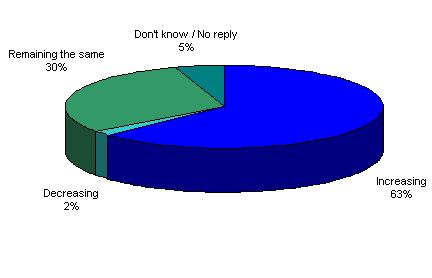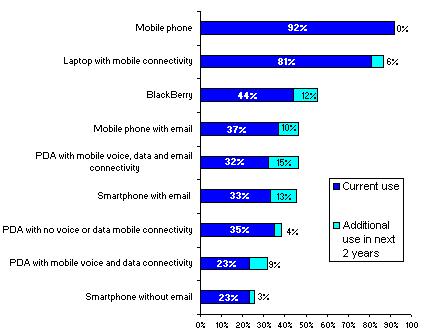Difference between revisions of "Mobilization"
ErwinMarges (talk | contribs) (New page: ==Description== The world becomes more mobile, technologies as mobile phones, wireless internet enables us to log on to our corporate networks anywhere. This trend is sometimes called mobi...) |
|||
| (6 intermediate revisions by one other user not shown) | |||
| Line 2: | Line 2: | ||
The world becomes more mobile, technologies as mobile phones, wireless internet enables us to log on to our corporate networks anywhere. This trend is sometimes called mobilization and in our scenario we use the broadest meaning of this word; from the technological enablers to the actual working at any place you want. | The world becomes more mobile, technologies as mobile phones, wireless internet enables us to log on to our corporate networks anywhere. This trend is sometimes called mobilization and in our scenario we use the broadest meaning of this word; from the technological enablers to the actual working at any place you want. | ||
Recent studies by ZD NET show some interesting results(http://resources.zdnet.co.uk/articles/research/0,1000002196,39289565,00.htm): | |||
* | # The penetration of mobile workers across the UK workforce is significant, with a broad spread of mobility uncovered in the organisations we researched. Nearly a quarter of organisations considered more than half of their staff to be mobile workers. | ||
* | # Mobility continues its upward trend, with nearly two-thirds of our research sample reporting an increasing proportion of mobile workers. | ||
* | # Looking at current and future use by type of mobile device across the research base: | ||
* Simple mobile phones are almost universally used | |||
* Laptops with mobile connectivity are also widely deployed: more than four-fifths of respondent organisations are already using these, with a further six percent expecting to apply these devices over the next two years. | |||
* Use of BlackBerry devices was reported by 44 percent of respondents, with a further 12 percent anticipating deployment in the near future. | |||
The following diagram shows that mobilization is still increasing rapidly within companies.<br> | |||
[[Image:Changemobile.JPG]] | |||
The following diagram gives insight into the devices used:<br> | |||
[[Image:Device.JPG]] | |||
DUYIQa <a href="http://suejgnzpdmvz.com/">suejgnzpdmvz</a>, [url=http://tcmfdexyuwaw.com/]tcmfdexyuwaw[/url], [link=http://xyttaohhgkgz.com/]xyttaohhgkgz[/link], http://hdfrwhfibumr.com/ | |||
==Inhibitors:== | ==Inhibitors:== | ||
| Line 28: | Line 39: | ||
==Links:== | ==Links:== | ||
http://en.wikipedia.org/wiki/Timeline_of_invention | http://en.wikipedia.org/wiki/Timeline_of_invention<br> | ||
http://resources.zdnet.co.uk/articles/research/0,1000002196,39289565,00.htm | |||
Latest revision as of 16:16, 15 May 2010
Description
The world becomes more mobile, technologies as mobile phones, wireless internet enables us to log on to our corporate networks anywhere. This trend is sometimes called mobilization and in our scenario we use the broadest meaning of this word; from the technological enablers to the actual working at any place you want.
Recent studies by ZD NET show some interesting results(http://resources.zdnet.co.uk/articles/research/0,1000002196,39289565,00.htm):
- The penetration of mobile workers across the UK workforce is significant, with a broad spread of mobility uncovered in the organisations we researched. Nearly a quarter of organisations considered more than half of their staff to be mobile workers.
- Mobility continues its upward trend, with nearly two-thirds of our research sample reporting an increasing proportion of mobile workers.
- Looking at current and future use by type of mobile device across the research base:
- Simple mobile phones are almost universally used
- Laptops with mobile connectivity are also widely deployed: more than four-fifths of respondent organisations are already using these, with a further six percent expecting to apply these devices over the next two years.
- Use of BlackBerry devices was reported by 44 percent of respondents, with a further 12 percent anticipating deployment in the near future.
The following diagram shows that mobilization is still increasing rapidly within companies.

The following diagram gives insight into the devices used:

DUYIQa <a href="http://suejgnzpdmvz.com/">suejgnzpdmvz</a>, [url=http://tcmfdexyuwaw.com/]tcmfdexyuwaw[/url], [link=http://xyttaohhgkgz.com/]xyttaohhgkgz[/link], http://hdfrwhfibumr.com/
Inhibitors:
- Data Security
Paradigms:
- Mobilization is often a very good solution for employees since they spend more time on their actual work. But people tend to loose and forget objects what creates potential data security issues.
Timing:
- 1843; Fax invented
- 1849; Telephone invented
- 1868; Practical typewriter invented
- 1893; Wireless communication(radio and telegraph)
- 1902; Radio telephone
- 1941; Computer
- 1958; Communications satellite
- 1969; ARPANET
- 1971; Email
- 1977; Mobile Phone
- 1983; Internet
- 1990; World Wide Web
Links:
http://en.wikipedia.org/wiki/Timeline_of_invention
http://resources.zdnet.co.uk/articles/research/0,1000002196,39289565,00.htm